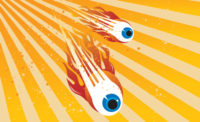Best-Selling Brands Offer Consumers Power to Explore Creative Individuality
Beyond Cults + Tribes


70,000 consumers responded to the MAC Cosmetics user-generated content campaign that encouraged celebrate their individuality.

The Cheetos brand has evolved from being a stand-alone snack to a source of inspiration for creative cooks.

WowWee’s Fingerlings invite consumers of all ages to adopt the pets and imbue them with their own personalities to create a like-minded friend.




Consumers latch onto brands that encourage freedom of expression and enable them to celebrate their individuality. Here’s my rationale: Brands that inspire tribal formations are adopted into consumers’ lifestyles. But what happens when those brands rest on their laurels a little too long by failing to remain innovative, or when new brands come along that pull on consumer heartstrings in a more relevant manner? Will consumers who are oriented to brands in a cult-like manner be likely to move to other brands that they find fresh and compelling—even when those brands are in different categories? Interestingly, research has corroborated this.
encourage creativity
For brands, staking out a position and standing for something is as important now as it ever was. Resisting the temptation to try to be all things to all people is crucial. Challenging the status quo is a big plus—and doing it in a unique, memorable manner is even better. Creating a brand persona is humanizing and encourages the formation of relationships. How enduring those relationships become depends upon whether the brand evolves with its adherents. Here’s where I think brands can take their marketing up a notch.
Instead of persuading consumers to subscribe to the specific attributes of a brand and its personality, why not think beyond achieving cult-like status and instead encourage individual creativity and expression? Why not use the brand as a springboard and its own personality as the impetus for consumers to explore their own ideas? I’m talking about going beyond offering customization and personalization, which took brands like Jones soda to the next level and added a cool factor to classic M&M’s. “Have it your way” is much more than a jingle now. But we can go even further than that.
Toy and entertainment brands are my passion. Although many brands within these categories have their own stories and personas, kids are encouraged to create their own stories around their favorite brands and to make them their own. There’s a lot to take from that. LEGO is an example of this kind of thinking, hence the huge popularity and success of the brand. The focus isn’t on selling basic bricks or toy sets, licensed or otherwise. The brand encourages kids to take its products and make whatever they choose. Take note: That’s more elevated than brands’ invitations to join the cults that they’re trying to establish. Interestingly, LEGO fans created a cult themselves and in the manner in which they chose. Even more interesting is the fact that LEGO fans continue to be rabid adherents of the brand even as adults. There’s a level of emotional connection there that doesn’t always remain in place when brands stake out lifestyle positioning.
Here’s my other observation: It has become popular for brands to create lifestyle imagery to which they expect consumers to aspire, and it’s tough to be on the receiving end of the barrage. Consumers just might be on lifestyle overload these days. Is it any wonder that they are reluctant to permanently subscribe to specific brands? Rather than being identified by brands, there is plenty of data suggesting that younger consumers are interested in brands that deliver memorable experiences.
encourage self-expression
Sounds great, but how many brands are like LEGO? How many sell consumer products that encourage individuality and creativity? Not enough. But the ones that do have a huge following. Think about how brands like Lays Potato Chips’ Do Us a Flavor contest became wildly successful by encouraging consumer submissions for new flavors. Oreo did the same thing. These brands allow consumers to have fun by coming up with combinations that range from fabulous to odd. Everybody understands that only a few entries will ultimately be chosen, but who cares? The buzz generated by this is immense as consumers light up social media with ideas and enthusiastic exchanges. Brand immersion and interactivity of this nature just might be more powerful than lifestyle branding. And contests are optional. Think of the sheer number of food brands that are marketing creative ways in which to integrate their products into nutritious, quickly prepared meals and the impact that this has had in the marketplace. The beauty of this is that it leads consumers to come up with their own imaginative creations.
Regardless of category, brands have an opportunity to market themselves in this manner. Suggesting that there are infinite possibilities fuels consumers’ imaginations and leads them to envision how they would adapt these brands in their own lives. Toy brands and tech brands are famous for doing just that. And there are many others. IKEA doesn’t sell home furnishings; it sells ideas that spur consumers’ imaginations about how they might furnish and decorate their own spaces. MAC Cosmetics launched #MACnificent Me, a year-long user-generated content campaign encouraging consumers to “celebrate your style, heart and soul” by submitting their own mantras about the essence of beauty. Is it any wonder that 70,000 consumers responded? Six winners were chosen; each with a unique, personal makeup style. No tutorials on how to apply makeup in a prescribed manner here. Creative women, from teenage pop stars to 90-year-old fashion icons represented the brand to women in MAC marketing campaigns. The message was: Isn’t it great to color outside of the lines and to just be yourself?
So what else can brands do to inspire consumers to embrace their own individual style and creativity?
the cheetos experiment
Who would have thought a pop-up restaurant in NYC with a Cheetos-inspired menu was possible? But it happened thanks to the star power of chef Anne Burrell, who was behind the creation of unique recipes, and the persona of Chester the Cheetah, who was featured in one-of-a-kind décor. Experience-hungry consumers pounced, and Frito-Lay created a brand sensation—not by trying to forge a cult but by offering consumers a memorable new way to experience the brand. The whole idea of recipes for every part of a meal concocted with Cheetos puffs spawned creative new ideas. In a world in which consumers are increasingly snacking rather than sitting down for meals, and in which there are limitless snack choices, how memorable is Cheetos’ new marketing approach? I think that the brand is onto something big.
leveraging package design
We need to realize that the brands I’ve been talking about are themselves being packaged to consumers in a unique manner. And actual product packaging? Let’s look at Cheetos. The brand has wisely developed the personality of Chester the Cheetah in its advertising, leveraging it within the pop-up restaurant and its packaging in an amusing, eye-catching manner. The cool cat is seen lassoing an jalapeno pepper with his tail while dressed in a cowboy hat and his signature shades on the brand’s Cheddar Jalapeno packaging. Chester is seen running from an angry bee with a honey pot stowed under his arm on the Honey BBQ packaging. On the brand’s XXTRA Flaming Hot variety, Chester’s tongue is on fire and flames are licking at the top and bottom of the packaging. We can see Chester Cheetah’s signature along with his paw print on pack, too. So what kinds of exciting things will consumers do with these flavors? Eat them straight out of the bag or invent new recipes?
monkeying around
We live within a hardworking, serious society. So when a brand comes along that appeals to our funny bone, it grabs our attention (kids and adults alike). That’s especially true if it’s interactive. There are plenty of high tech robotic “pets” out there, but there isn’t anything quite like the industry’s hottest toy, WowWee’s Fingerlings. The endearing baby monkeys literally wrap themselves around human fingers, swing by their tails, blink their eyes, blow kisses and babble in monkey-speak.
But are Fingerlings toys? Collectibles? New pals? It’s up to consumers to decide that. This brand is clearly not about marketing a story. It instead appeals to consumers who will infuse their own personalities and storylines into their new friends. Simple package design gets the point across succinctly. A unique logo features a font with long tails on the letter “g” in the Fingerlings name. The copy sums up the toy in four words: “friendship @ your fingertips.” The cute baby monkey appears with clasped hands and feet in front of a tree. The brand communication “40+ sounds” appears on a bunch of bananas right next to it. In the upper right-hand corner, there’s a visual of three people with Fingerlings wrapped around their fingers.
Will Fingerlings be a fad, or will the brand imaginatively evolve and grow to keep consumers’ fleeting attention and eventually engender powerful relationships and undying loyalty? It will if the brand continues to seize consumers’ imaginations as Hatchimals have done, prompting them to form their own cult in their own way.
Looking for a reprint of this article?
From high-res PDFs to custom plaques, order your copy today!










